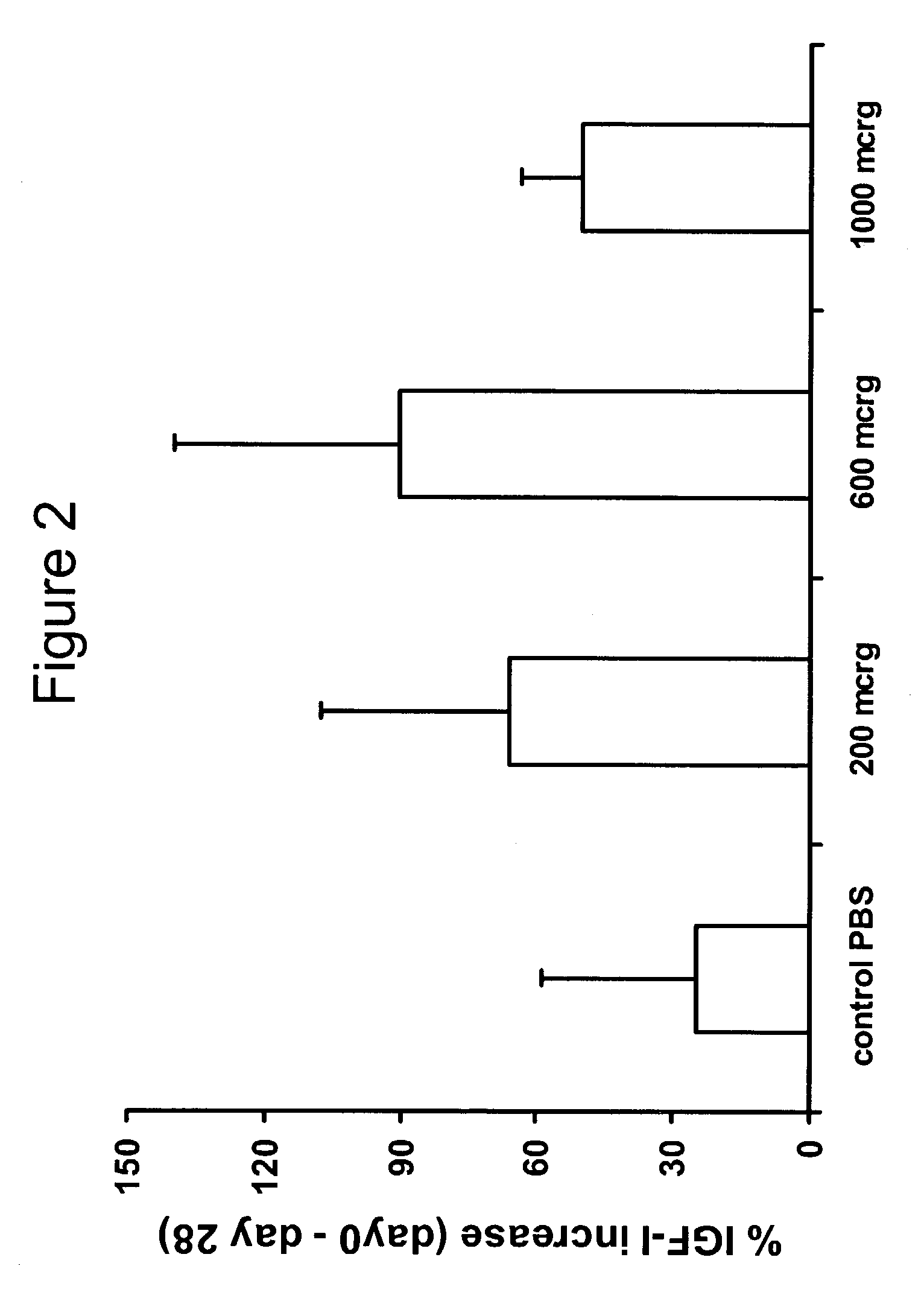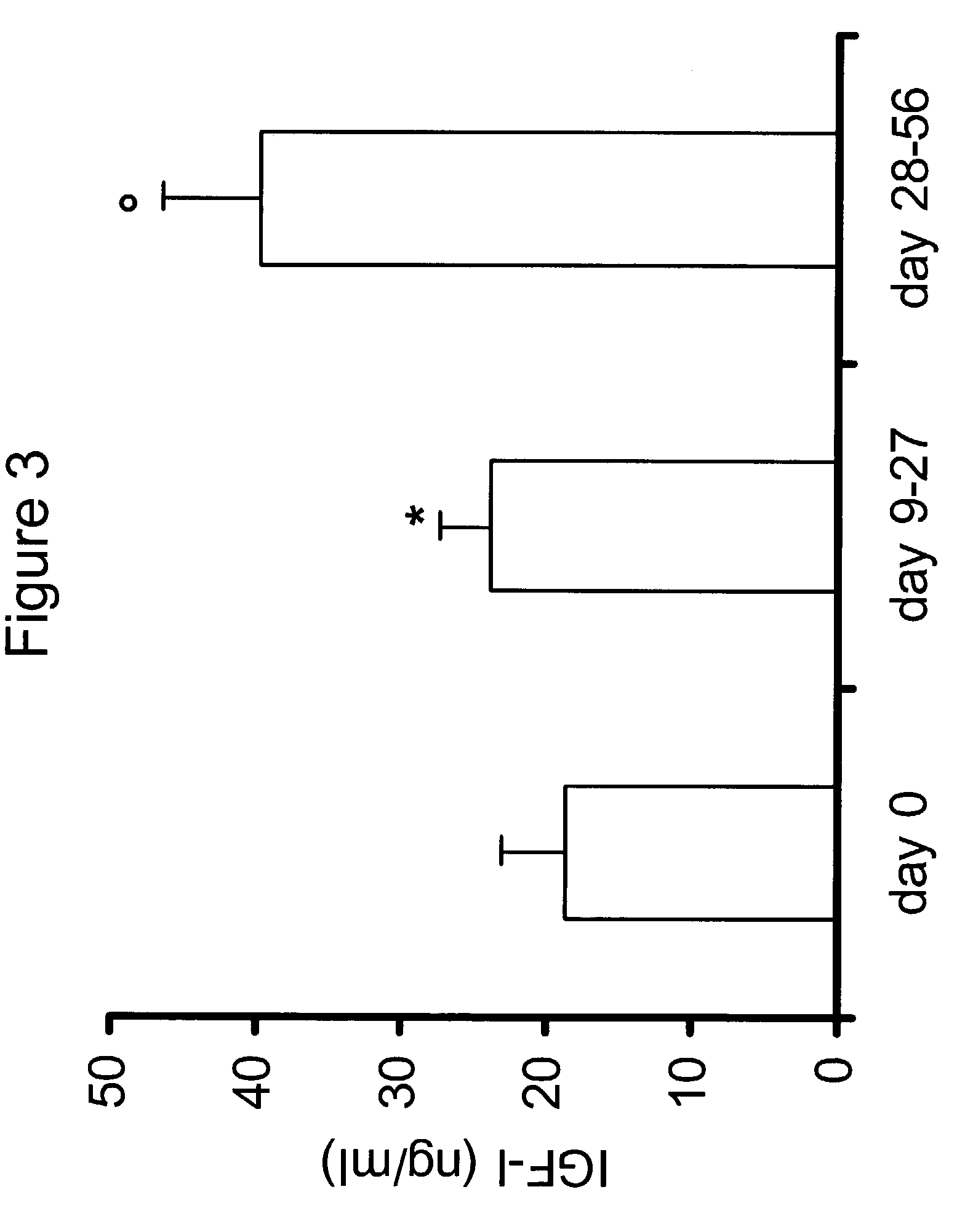Treating anemia in subjects by administration of plasmids encoding growth hormone releasing hormone
a technology of plasmids and anemia, applied in the field of plasmid-mediated supplementation, can solve the problems of ineffective erythropoiesis, hemolysis, varying degrees of anemia, and inability to effectively treat anemia, and achieve the effects of reducing the risk of anemia, improving the survival rate, and improving the survival ra
- Summary
- Abstract
- Description
- Claims
- Application Information
AI Technical Summary
Benefits of technology
Problems solved by technology
Method used
Image
Examples
example 1
Construction of DNA Vectors and Methods in Animal Subject
[0196]In order to treat anemia; increase total red blood cell mass; reverse the wasting; reverse abnormal weight loss; treat immune dysfunction; reverse the suppression of lymphopoesis; or extend life expectancy for the chronically ill subject, it was first necessary to design several GHRH expression constructs. Briefly, the plasmid vectors contained the muscle specific synthetic promoter SPc5-12 (Li et al., 1999) attached to a wild type or analog porcine GHRH. The analog GHRH sequences were generated by site directed mutagenesis as described in methods section. Nucleic acid sequences encoding GHRH or analog were cloned into the BamHI / HindIII sites of pSPc5-12 plasmid, to generate pSP-GHRH. Other elements contained in the plasmids include a 3′ untranslated region of growth hormone and an SV40 3′UTR from pSEAP-2 Basic Vector as described in the methods section. The unique nucleic acid sequences for the constructs used are shown...
example 2
Low Voltage Electroporation for DNA Uptake and Expression in an Animal Subject
[0213]Direct intra-muscular plasmid DNA injection followed by electroporation is a method for the local and controlled delivery of plasmid DNA into skeletal muscle. It has the advantage that is uses low plasmid quantities (as low as 0.1 mg), rather than the high quantities typically used with passive delivery modalities. Although not wanting to be bound by theory, the mechanism of the increased plasmid uptake by electroporation probably occurs through newly created membrane pores with or without protein active transport. Although not wanting to be bound by theory, the degree of permeabilization of the muscle cells is dependent on the electric field intensity, length of pulses, shape and type of electrodes (Bureau et al., 2000) (Gilbert et al., 1997), and cell size (Somiari et al., 2000). Classical electrode configuration, plates or a pair of wire electrodes placed 4 mm apart were shown to be effective in r...
example 3
Increased Survival in Animal Subjects with Cancer
[0216]Eleven injected dogs with cancer had survived for at least 56 days after the injection, and complete data was collected in all cases. The dogs enrolled in the study were in a relatively advanced stage of their disease (206 days since the beginning of the therapy). The average survival post-injection is listed in FIG. 18. At the time this application was prepared, 8 out of the eleven treated dogs were still alive (average survival post injection 150.6 days). The 19 control dogs were in a less advanced stage of disease and had an average survival of 56 days after the initial diagnosis. In contrast, after the enrollment into the present study the average survival post enrolment was 162.5 days. Five control animals died during this period. The quality of life in the treated patients increased. No adverse effects linked to the therapy were noted by owners. Three owners noticed a dramatic improvement in the general well-being of the t...
PUM
| Property | Measurement | Unit |
|---|---|---|
| Composition | aaaaa | aaaaa |
| Biological properties | aaaaa | aaaaa |
Abstract
Description
Claims
Application Information
 Login to View More
Login to View More - R&D
- Intellectual Property
- Life Sciences
- Materials
- Tech Scout
- Unparalleled Data Quality
- Higher Quality Content
- 60% Fewer Hallucinations
Browse by: Latest US Patents, China's latest patents, Technical Efficacy Thesaurus, Application Domain, Technology Topic, Popular Technical Reports.
© 2025 PatSnap. All rights reserved.Legal|Privacy policy|Modern Slavery Act Transparency Statement|Sitemap|About US| Contact US: help@patsnap.com



